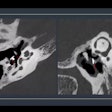Head and neck cancer is too rare to screen for in the general population, but using CT to screen those who are also being checked for lung cancer draws a relatively high yield of malignancies, according to an analysis published online in Cancer.
Those most at risk for lung cancer also have the highest risk for head and neck cancer, and results of the current study bear out this association, offering a strong rationale for a national clinical trial to evaluate the effectiveness of adding head and neck cancer screening for individuals who qualify for CT lung cancer screening programs.
Among the more than 3,500 participants in the Pittsburgh Lung Screening Study (PLuSS), 23 patients developed head and neck squamous cell carcinoma (HNSCC) -- the most common form of head and neck cancer -- over the course of follow-up. That's significantly more than the approximately 14 cases predicted by U.S. Surveillance, Epidemiology, and End Results (SEER) data.
"This study was a first step toward determining whether adding head and neck cancer screening to lung cancer screening would be useful," co-author Brenda Diergaarde, PhD, from the University of Pittsburgh told AuntMinnie.com in an email.
The results suggest that it may indeed be useful to examine individuals who come in for lung cancer screening for head and neck cancer as well, noted lead author Ronak Dixit, along with colleagues including Dr. Joel Weissfeld, Dr. David Wilson, and Diergaarde (Cancer, January 5, 2015).
The world's sixth most common cancer, head and neck cancer is diagnosed in approximately 600,000 patients each year. More than half are squamous cell carcinomas, and tobacco and alcohol use are major risk factors for its development, the authors wrote.
"Given that cigarette smoking is also one of the primary risk factors for head and neck cancer, we hypothesized that it may be efficacious to screen for head and neck cancer in individuals at risk for smoking-related lung cancer as well," the authors wrote. "Stratification of head and neck cancer risk based on known risk factors and targeting only individuals at high risk for screening may be more feasible and successful."
The PLuSS cohort included current and former smokers 50 years or older with a smoking history of at least 12.5 pack-years. Ex-smokers must have quit within the past 10 years.
Dixit and colleagues looked at medical records, death certificates, cancer registry information, and data from participant-administered questionnaires, including demographic and smoking history information, to determine the number of HNSCC cases in PLuSS. Participants described their medical history, current medical problems, and new cancer diagnoses, and each year they completed an annual study update questionnaire.
The researchers then used incidence rates from SEER data for 2000 to 2011 to calculate standardized incidence ratios to assess the difference between the observed and expected numbers of HNSCC cases.
Among the 3,587 participants at risk but without a history of HNSCC, 23 (0.64%) developed HNSCC over a median 9.5 years of follow-up, for a total HNSCC incidence of 71.4 cases per 100,000 person-years. In comparison, sex-, race-, and age-specific rates obtained from SEER totaled about half as many cases, or 13.7.
Dividing the observed by the expected cases produced a standardized incidence ratio of 1.68 (95% confidence interval: 1.06-2.52, p = 0.027), meaning that screening this group identified almost twice as many HNSCC cases as SEER data predicted.
The participants' mean age at enrollment and smoking status were similar between the incident HNSCC cases and other participants in the lung cancer screening trial, the researchers noted. The patients comprising the 23 incident HNSCC cases were more often male, started smoking younger, smoked more cigarettes per day, and had more pack-years of smoking versus those who did not develop the disease.
The majority of cases (56.5%) were diagnosed with cancer of the oral cavity or pharynx. Median time in PLuSS before HNSCC diagnosis was 5.1 years, according to Dixit and colleagues.
Need for strategies
Most new head and neck cancer cases are diagnosed as regional or distant disease; five-year survival rates are 61% (regional) and 37% (distant) for oral cavity and pharyngeal cancer and 43% (regional) and 35% (distant) for laryngeal cancer. These survival rates have improved little over the past several decades, the authors noted.
"Thus, there is a strong need to develop strategies that will result in the identification of head and neck cancer at an earlier stage when it can be curatively treated," they wrote, adding that free screening programs for HNSCC have generally not been successful.
The results suggest there is a potential benefit to screening individuals at high risk for lung cancer for head and neck cancer as well, the authors wrote.
They pointed out that even though tobacco use plays a role in most HNSCC cases, individuals who are nonsmokers but have a high HNSCC risk due to heavy alcohol consumption or human papillomavirus (HPV) infection will be missed by this screening strategy.
Based on the accessibility of the head and neck area for physical examination, the possibility of identifying premalignant lesions and early-stage tumors, and the easily identifiable risk factors, HNSCC seems particularly suited for screening programs that target high-risk subjects.
At the same time, in its most recent oral cancer screening recommendations, the U.S. Preventive Services Task Force (USPSTF) concluded that uncertainty regarding the harms of overdiagnosis and treatment, as well as patient anxiety, makes the evidence still insufficient to support HNSCC screening.
The authors recommend a clinical trial based on the present study.
"In order to move forward, it will therefore be important to determine the accuracy of current screening methods and whether head and neck cancer screening actually reduces mortality and/or morbidity among those at high risk and is cost-effective," they wrote.
"Randomized trials are needed to assess the benefits and harms ... of adding examination of the head and neck area to lung cancer screening programs," Diergaarde added in her email. "We are currently working with otolaryngologists to design a national trial that would determine this."



















